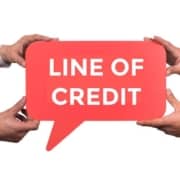The Benefits of Business Lines of Credit
For small business owners that have ongoing business expenses and uneven cash flows, a business line of credit may be the most convenient and useful financing method in your toolbox.
Too often, however, small business owners confuse a business line of credit and a business credit card and end up paying a higher interest rate on revolving debt as a result.
What is a Business Line of Credit?
A business line of credit is typically an unsecured line of credit that can be granted to a small business by either a bank or an alternative lender. The line of credit has a predetermined limit set by the lender (and it’s typically higher than a business credit card) based on the risk you present as a borrower, and like a business credit card, can be used to address any expense that arises for your business.
Unlike other types of typical small business loans, with a business line of credit, there is no lump-sum disbursement of funds that requires a subsequent monthly payment, and you don’t have to specify to the lender exactly what you intend to use the funds for.
Also, similar to a credit card, your debt will be revolving, and interest will be accrued only on the amount that you have borrowed. The line of credit typically is subject to a periodic review and renewal, often annually..
Business Line of Credit vs. Business Credit Card
While both a business line of credit and a business credit card are forms of revolving debt that are typically used for short-term funding needs, the main differences between them are the interest rate and what they generally are used for.
A business credit card can charge more than 20% APR for purchases, and an even higher rate for cash advances. The rate for a business line of credit usually ranges between 10% to 15%, and the rate will still be the same when you use the line of credit for cash.
What are Each Used for?
A business line of credit and a credit card may also be used for different reasons. Lines of credit are sometimes used by seasonal small businesses that need funds to cover operating expenses during slow periods of the year, such as payroll; or when it has an unexpected expense. Small businesses can also use their lines of credit to gain access to funds without having the hassle or expense of applying for a loan, and the repayment terms are often more flexible than with business credit cards.
On the other hand, a small business credit card will come in handy for smaller purchases that you typically wouldn’t use your line of credit for, such as when you have to pick up the tab for a business meal or need to buy a new inkjet printer for the office and don’t wish to make a trip to the bank to withdraw the funds. A credit card also often offers perks such as cash back offers or travel miles that a line of credit would not.
Once again, be warned that business credit cards typically offer a lower credit limit than a business line of credit and are more expensive.
What is a Secured vs. Unsecured Line of Credit?
An unsecured line of credit is not guaranteed by collateral. Typically, it will carry a higher interest rate than a secured line of credit because the lender is taking on greater risk than with a secured line of credit. It is usually granted to businesses that have been in operation for several years and have consistently strong annual revenues.
With a secured line of credit, you will usually be granted a large business line of credit with a higher spending limit because it is guaranteed by physical assets, which lenders prefer. Some banks, however, may ask that your personal assets be used to secure your line of credit, while alternative lenders typically just ask for your business assets. A lender may also require that you secure your line of credit if you require a limit of more than $100,000.
How Do You Qualify for a Line of Credit?
Business lines of credit are generally more difficult to obtain than business credit cards. Typically, small business owners that have a FICO score of at least 650 and have been in business for at least two years with annual revenue of at least $180,000 will qualify for a business line of credit, but those terms will vary depending on which lender you are doing business with. Alternative lenders often will have less stringent requirements.
Small businesses that don’t qualify for a business line of credit because they don’t have a long history in business or a profit margin that’s too low may find a business credit card to be useful, and there are plenty of them out there that offer perks and cashback rewards.
In general, however, a business line of credit can be a great reward for small business owners that have worked hard to establish their businesses over time.







